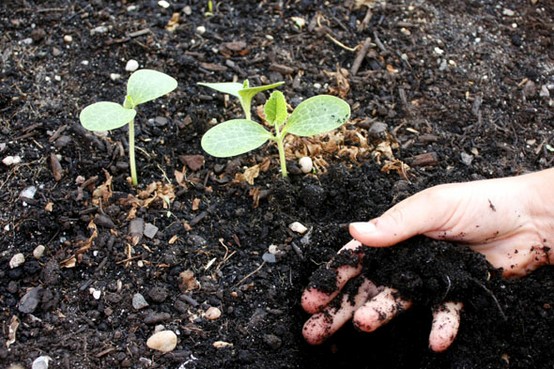Today we have a guest post by Susie of Our Simple Farm…
As gardening is coming into full swing, this is a great time to work with our children and teach them the many aspects of gardening. Soil conditioning is a very important teaching subject! My children like to grow things, but they also have to know that they can’t just put the seed in the ground and expect it to grow and produce fruit. Some important things to know before planting are to make sure the soil is fertile enough and that it has the right balance of nutrients.
So, what’s it going to take to get your garden soil healthy? Couldn’t you just spray some water soluble fertilizers on the young plants to give them the nutrients they need? Let me explain why I believe that this is not a sustainable method. But first, let me quote Eliot Coleman, a master at organic gardening and author of The New Organic Grower;
“The things that turn an infertile soil into a fertile soil are minerals and organic matter. If these are provided, the soil can excel on its own merits. Instead of a temporary crutch that must be provided time after time, a process is established that becomes self-sustaining. A fertile soil, like an educated mind, is a cumulative process, and with care it is capable of continuous improvement.”
Can I get an amen? We must condition our soil and not the plant. A gardener might add soluble fertilizers and get good results, but, he will have poor soil year after year. You see, the plant gets fed, but the soil does not. That is what you see in most corn and bean fields, infertile soil with huge healthy looking corn and soybeans. They normally do not condition the soil, but apply plant fertilizer year after year after year. Sustainable? I don’t think so. And, sadly, many gardeners are following this model as well.
What if we conditioned the soil so that we did not have to apply certain ammendments year after year? What if we used natural rock minerals so that the nutrients is readily available without upsetting the natural balance of the soil? I believe this is a healthier, more sustainable approach. But, what exactly does conditioning the soil mean?
Let me give you Simple Susie’s way of sharing simple soil solutions in a simplified way so that simple folk like you and me can simply figure it out! Whew!
Oh, and by-the-way, it will keep your garden budget pretty simple too!
Nitrogen. Compost and/or composted manure is the best ammendment you can make with a zero budget. If you have grass eating animals, capitalize on the manure! You can put it on your garden in the fall and till it in, or, once it has been composted, apply it in the spring. You need at least 2-3 inches of this black gold. There are many ways to start composting and many sites will show you this simple way of applying organic matter. The best thing about compost/manure is that you can apply it every 2 years, not every year! Now we’re talkin’!
Phosphorous. Rock phosphate is a finally ground rock powder that only needs to be applied every four years. After taking my soil test, phosphorous was pretty depleted in some areas, so, rock phosphate will be needed!
Potassium and micronutrients. Greensand is a seabed deposit that not only contains some potassium, but essential micronutrients as well. You can also use dried seaweed, but it can be a little pricey! Greensand can be applied the first and second year, then it will not need to be applied until four years later! If you find that you are sufficient in potassium the second year, you might not need it.
Soil pH. Limestone rock in it’s natural form has calcium and magnesium that will raise the pH level. Sufficient levels range from 6.2-6.8 although some will give slightly different numbers. Depending on what your soil test reads the following year, you might not need to add lime every year.
Planting green manures(cover crops that you till in) is an excellent way to maintain your soil fertility once you have applied the above nutrients. You can do this after the planting season is over, or as a spring cover crop that can be quickly tilled in. Another great way to plant cover crops is by undersowing them the following year. This simply means that you plant them in between rows a few days after your plants have become established in your garden.
I will leave you with one of our Garden Prep Week How-to videos on double digging!
If you would like more information on Garden Prep Week and the how-to videos at Our Simple Farm, go here.
My name is Susie, a helpmeet to my awesome husband of 12 years and a homeschooling mother of five wonderful children, with two in heaven. We live on a 25 acre farm with horses, goats, chickens, pigs and Great Pyrenees dogs. The Lord has blessed us with this land and old farmhouse, so, we in turn, seek to glorify Him with what we have. It is quite an adventure, with never a dull moment here at the Shock Farm! I would love for you to visit me at my new blog, oursimplefarm.com, and get a closer look at what we do here.







